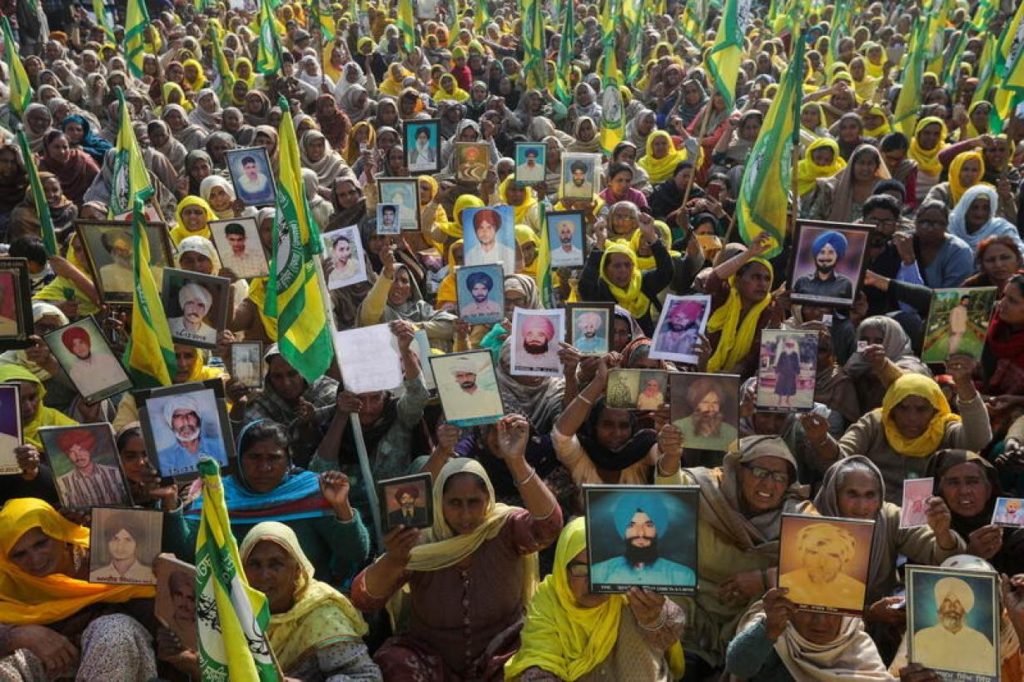
It is important for the Indian farmers’ protest movement currently unfolding in New Delhi, India, to be seen as intersectional feminist issue.
Farmers from the Punjab are protesting the latest laws of the Indian government designed to now hand over to the billionaires—who already hold this poor country’s wealth since the so-called liberalization of the 1990s.The farmers are calling attention to the government’s colonizing of the agrarian sector. Among networks covering news about the farmers’ protest in New Delhi, we see only male farmers and male protesters and male speakers. Where are the women, especially since the state of Punjab is rife with violence against women, a warped sex ratio, and the wide economic gap between the genders? The reality is that women farmers all over India are underrepresented in the news. They do the same work as men and use machines that are easier for men to use than for women. In the spate of suicides among farmers that we have seen in the past decade, women farmers are part of this statistic, but did not make the news. According to Surbhi, “out of total 8007 farmers suicide in 2014, 441 were female farmers.” Additionally, the women are affected by the farmers who commit suicide, since now they become the sole supporters of their families and receive no welfare form the government. Undervalued, women farmers are the building blocks of the country’s economy.
What is the reality on the ground during the current farmers’ protest in New Delhi? Women from across villages and towns in Punjab have traveled to Delhi to speak. When a women protests, she is speaking for her whole family and for her whole village of farmers. Women protestors are enlightening the public about the bias against female farmers who are called agricultural laborers and are paid less and given poorer implements and are exposed to toxic chemicals. In fact, the women farmers work hard for long hours and do the same kinds of work as their male counterparts, from sowing and harvesting, to threshing and winnowing.
The farmers are protesting not just the lack of control over the prices of their products but the corporate pressure to use GMO seeds. In a recent Twitter post, Vandana Shiva states, “In 1984 Punjab farmers were protesting against the #GreenRevolution model saying if you cannot choose what you grow or how you will grow it , these are conditions of slavery . They have already paid a very high price with debt , suicides & a #CancerTrain”. Shiva’s ecological activism is based on understanding that the exploitation of the earth and our ecology is both intersectional and transnational. She traces back the exploitation of the most vulnerable, earth, women, and the poor to colonialism and capitalism. In the same Twitter feed, Shiva argues, “No one was dying of famine in India in 1965 when the World Bank & US govt imposed the #GreenRevolution on Punjab to sell left over war chemicals. Chemical Monocultures of dwarf rice & wheat forced on farmers use 10 times more water.” Here is an example of economic colonialism at play, which in another 60 years has not subsided but increased in power.
As Shiva and other feminist activists see, a stitching together of agricultural activism across borders can impact governments subservient to corporate interests. In the current farmers’ protest, Sikh women in the U.S., Canada, Amsterdam, are taking to the streets, bringing attention to their farming families spread over the diaspora. As Ramanpreet Kaur, one of the Sikh activists in Queens, New York says, “Even if you don’t feel a personal connection to India or the farmers out there like many of us do, as a human being who lives on earth you should be concerned about exploitation of the people who feed you everyday.”
Women activists who are part of the long arc of farmer activism in Indian history are not only protesting the Indian state with its development model but also patriarchy and capitalism. Currently organizations such as Mahila Kisan Adhikaar Manch (MAKAAM) are on the ground offering the strong voices of women farmers.
In other parts of India, there are grassroots movements such as Fatima Burnad’s Society for Rural Education and Development (SRED), which lists support of women farmers as part of the intersectional model. SRED challenges the oppression of Dalit and women laborers. These movements are intersectional and bring religious, caste, communal, and gender perspectives into the fight for farmers’ rights.
What is interesting about the Sikh farmers is that Sikhism as a religion is critical of caste discrimination and religious divisions. Men and women were equally active during partition. They are admired for their warrior spirit and their generosity. At the height of the protest, the farmers offered langaar, or food donation, to all protesters—a sign of their good will despite the draconian measures they are battling. The farmers are careful not to let the news media misconstrue their protest into a religious protest or the 1980s disastrous “Khalistan” protest. They do not want to be labeled anti-national. In fact, the stories about women farmers can become the linchpin for any success that can be seen in this latest farmers’ protest movement. In addition, feminist protests across the globe can show solidarity with the farmers and increase pressure on the Indian government and point to the danger to food, earth, and human and animal health.
Pramila Venkateswaran
(Photo Credit: Reuters / Anushree Fadnavis)